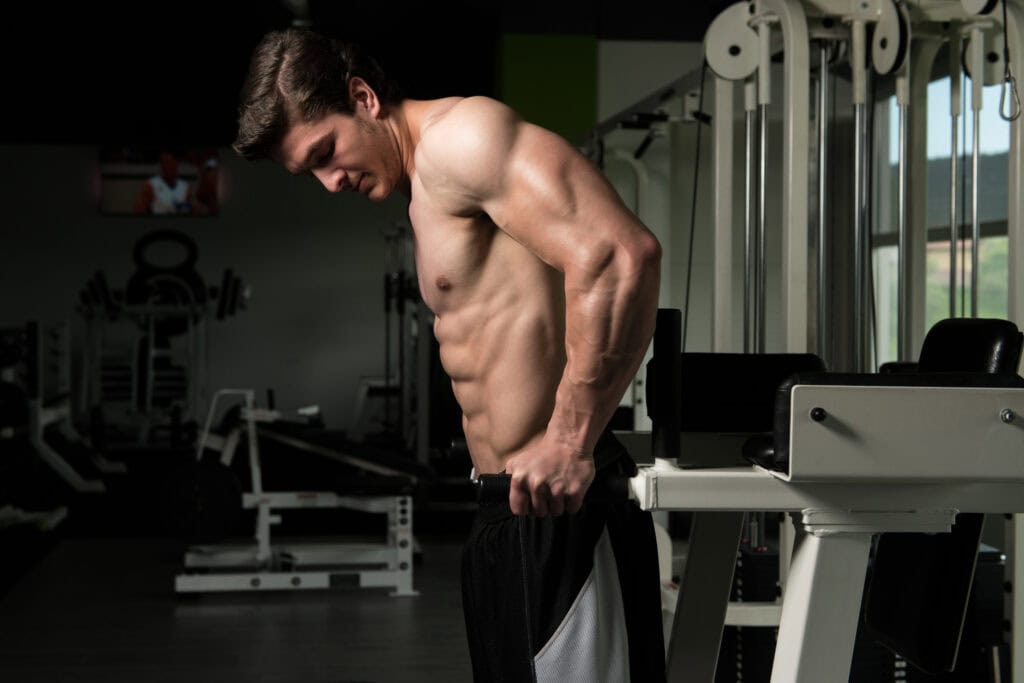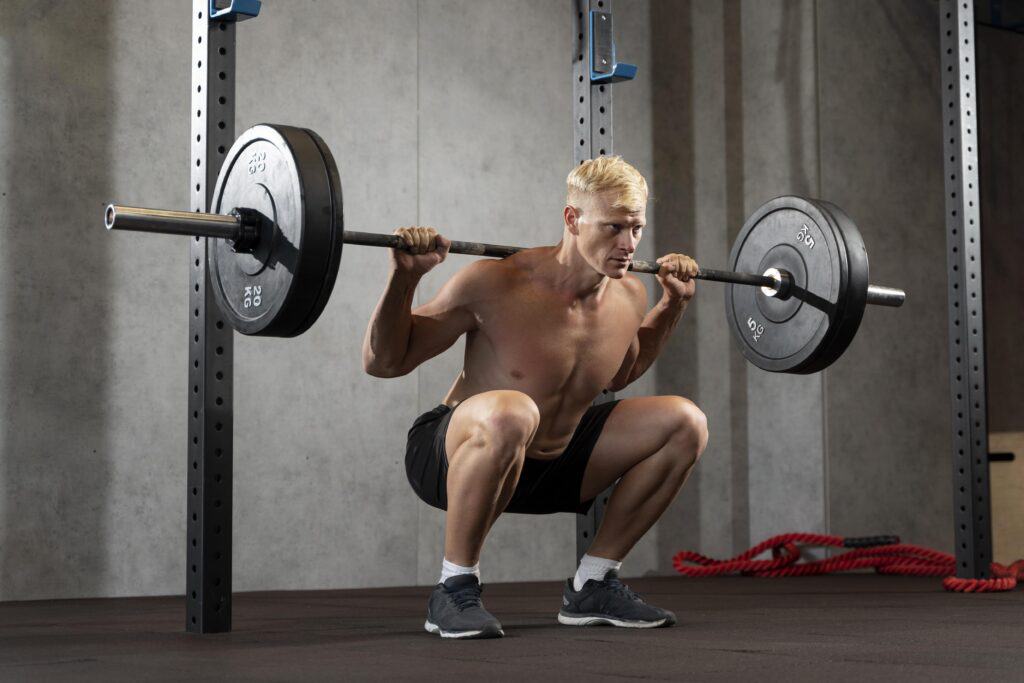When it comes to building strength and muscle, choosing the right exercises can make a huge difference in results. Electromyography (EMG) studies provide valuable insights into which movements activate muscles the most, allowing you to target each muscle group effectively. In this article, we’ll explore the best exercises for the legs, back, chest, shoulders, core, and arms, according to science and EMG data. These exercises not only offer the most “bang for your buck,” but they also ensure optimal muscle activation for strength and growth.
1. Legs: Barbell Back Squat
The barbell back squat reigns supreme when it comes to leg development. EMG studies show that squats produce the highest muscle activation across the quadriceps, hamstrings, and glutes compared to other leg exercises like leg presses or lunges. The versatility of the barbell squat allows it to target multiple muscle groups, making it an efficient exercise for overall leg strength and hypertrophy.
- Muscle Activation: Squats have been shown to produce up to 74 percent maximum voluntary contraction (MVC) in the quadriceps, 52 percent in the glutes, and 43 percent in the hamstrings during the ascent phase.
- Why It’s Effective: The squat engages nearly every muscle in the lower body, improves core stability, and boosts functional strength. Additionally, heavy squats increase anabolic hormone production, leading to overall muscle growth.
Pro Tip: To maximize EMG activation, aim for a full range of motion and proper form. Ensure your thighs are at least parallel to the floor at the bottom of the movement to fully engage the quadriceps and glutes.
2. Back: Pull-Up
For optimal back muscle activation, the pull-up is the best choice. EMG data consistently shows that the pull-up, particularly the wide-grip variation, activates the latissimus dorsi, trapezius, and rhomboids more than other back exercises, including lat pulldowns and barbell rows.
- Muscle Activation: The pull-up yields 117 percent MVC in the latissimus dorsi, 92 percent in the middle trapezius, and 86 percent in the rhomboids, outperforming rows and pulldowns.
- Why It’s Effective: Pull-ups require tremendous upper-body strength and engage the entire posterior chain, including the lats, traps, rhomboids, and even the biceps. It’s a compound exercise that trains multiple muscle groups at once, offering maximum efficiency.
Pro Tip: To enhance back muscle activation, focus on a full range of motion and initiate the movement with your lats rather than your arms.
3. Chest: Barbell Bench Press
The barbell bench press remains the gold standard for chest development. EMG studies show that the bench press elicits the highest pectoral muscle activation when compared to other chest exercises like the dumbbell fly or push-up. This movement also activates secondary muscles such as the triceps and shoulders, making it a well-rounded exercise for upper-body strength.
- Muscle Activation: The bench press achieves up to 95 percent MVC in the pectoralis major, with additional activation in the anterior deltoids (79 percent) and triceps (67 percent).
- Why It’s Effective: The barbell bench press allows for progressive overload, meaning you can continuously increase the weight, leading to better muscle hypertrophy over time.
Pro Tip: To maximize chest activation, lower the bar slowly to your chest and push explosively upwards, maintaining control throughout the movement.
4. Shoulders: Overhead Barbell Press
When it comes to shoulder development, the overhead barbell press (also known as the military press) ranks at the top. EMG studies highlight that this compound movement generates greater muscle activation in the deltoids compared to lateral raises, front raises, or machine presses.
- Muscle Activation: The barbell overhead press activates the anterior deltoids (79 percent), lateral deltoids (66 percent), and triceps (61 percent) at high levels, far outperforming isolation exercises like dumbbell raises.
- Why It’s Effective: This exercise not only focuses on the shoulder muscles but also engages the core, upper chest, and triceps, providing comprehensive upper-body strength.
Pro Tip: To avoid injury and maximize gains, ensure you maintain a neutral spine and engage your core throughout the movement.
5. Core: Plank
The plank is the most effective exercise for core activation, according to EMG studies. Unlike traditional crunches or sit-ups, which primarily target the rectus abdominis, the plank works the entire core, including the transverse abdominis, obliques, and even the lower back.
- Muscle Activation: The plank results in 100 percent MVC in the rectus abdominis, along with significant activation in the obliques (90 percent) and lower back muscles (85 percent).
- Why It’s Effective: The plank is an isometric exercise that trains your core for stability, making it a functional movement that translates well to other exercises. It also helps improve posture and prevent lower back pain.
Pro Tip: For maximum effectiveness, hold the plank position with a straight back and engaged glutes, avoiding any sagging or arching.
6. Anterior Arm: Barbell Bicep Curl
The barbell bicep curl is the top exercise for arm muscle activation, specifically for the biceps brachii. EMG studies show that the bicep curl, when performed with a barbell, produces greater muscle activation compared to dumbbell curls or cable curls.
- Muscle Activation: The barbell bicep curl generates up to 96 percent MVC in the biceps brachii, compared to 76 percent in hammer curls and 60 percent in preacher curls.
- Why It’s Effective: The barbell curl allows for a controlled, isolated contraction of the biceps, providing maximum muscle activation. It also allows for the use of heavier weights compared to other variations, leading to greater strength gains over time.
Pro Tip: Keep your elbows close to your torso throughout the movement to ensure that the biceps are doing all the work. Avoid swinging the bar for momentum, as this reduces muscle activation.

7. Posterior Arm: Machine Dip
For triceps development, tricep dips top the list. According to EMG research, this bodyweight exercise outperforms machine and cable exercises in activating the triceps brachii, especially when additional weight is added.
- Muscles Targeted: Triceps Brachii, Chest (Secondary), Shoulders (Secondary)
- EMG Activation: Tricep dips achieve 85-90 percent activation of the triceps brachii.
- Why It’s Effective: Tricep dips work multiple upper-body muscles while primarily focusing on the triceps. As a compound movement, they also engage the chest and shoulders, providing a well-rounded upper-body workout.
Conclusion
To maximize muscle growth and strength, selecting exercises that activate the most muscle fibers is crucial. Based on EMG data, the barbell back squat for legs, pull-up for back, bench press for chest, overhead barbell press for shoulders, plank for core, and barbell bicep curl for arms offer the best bang for your buck. These exercises not only provide the highest muscle activation but also engage multiple muscle groups, allowing for efficient and effective workouts.
By incorporating these science-backed movements into your routine, you’ll optimize your results and build a strong, balanced physique. Make sure to focus on proper form and progressive overload to continue making gains over time. This comprehensive guide helps you hit all major muscle groups with exercises backed by EMG data to maximize muscle activation and efficiency.
References
- Contreras, B., et al. (2010). The Best Exercises According to EMG Data. Strength and Conditioning Journal.
- Andersen, V., et al. (2014). Electromyographic Comparison of Barbell, Dumbbell, and Kettlebell Exercises. Journal of Strength and Conditioning Research.
- Schick, E., et al. (2010). Comparison of Muscle Activation between Push-up Variations and Bench Press. Journal of Human Kinetics.
Stay Strong Together
If you’re serious about building muscle and reaching your fitness goals, the Jefit app is the perfect tool to help get you there. With over 20 million downloads and more than 12 million bodybuilders using the app to track their workouts, Jefit is the ultimate strength training companion. Rated as the 2023 Best App and featured by top publications like Men’s Health, PC Magazine, and USA TODAY. Jefit boasts 42,000+ five-star ratings for its user-friendly design and comprehensive features. Whether you’re focused on protein intake, building strength, or tracking your progress, Jefit has everything you need to succeed. Download Jefit today and join millions of fitness enthusiasts transforming their bodies!
- Whey vs. Casein: What’s the Best Protein for Building Muscle - April 18, 2025
- Four Popular Jefit Chest Exercises Backed by Science - April 16, 2025
- 4 Must-Have Exercises Backed by Science for a Full-Body Workout - April 14, 2025
